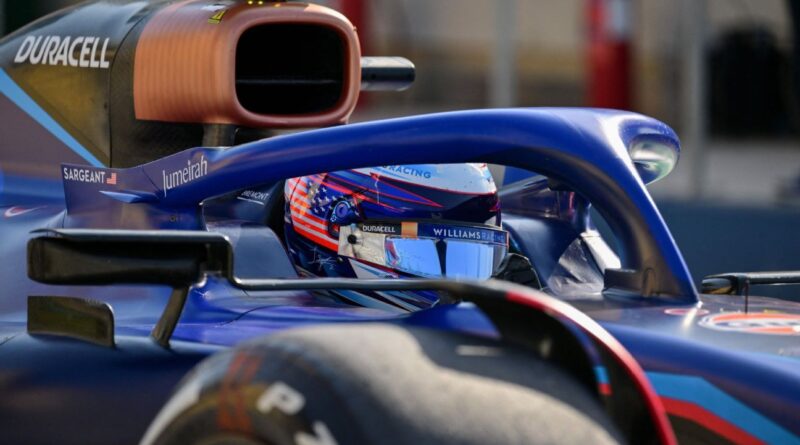Why aren’t more Americans following Sargeant into F1?
It has been 5,799 days and counting since an American driver with a full-time Formula One seat contested a U.S. Grand Prix. Scott Speed finished 13th at Indianapolis in 2007 for what was then known as Scuderia Toro Rosso, and it would be the last time he would see the checkered flag in the series before losing his ride to some kid named Sebastian Vettel.
Come Sunday afternoon, when the lights go out on the Miami Grand Prix (2 p.m. ET, stream live on ABC and ESPN+), the wait will have reached 5,804 days. It’s not difficult to imagine, then, the expectation that surrounds — and the enthusiasm that fills — Florida-born Williams Racing rookie Logan Sargeant.
“I think I’ve gotten hundreds of ticket requests for Miami, and I feel bad telling people I can’t get any,” he told ESPN last month. “I’m trying to get some for the close friends and family, but it’s not as easy as everyone thinks.”
In between Speed and Sargeant, there was Alexander Rossi, a now-31-year-old who appeared in five races during the 2015 season for Manor Marussia. Ever since, the Californian has honed his craft in IndyCar, where he has won eight races, but he is the rare American to have worked their way up the junior-formula ladder with an eye on making it into F1.
Since Rossi left Europe behind (and GP2, now called Formula 2), just two drivers from the U.S. have completed full seasons in the feeder series — Sargeant is one of them.
The scarcity of American-born prospects in the junior formulas that lead talented-enough drivers to the gates of F1 has no simple explanation. There are several contributing factors, though.
For a start, up until the advent of the Netflix docuseries “Drive to Survive,” the sport hasn’t been particularly popular in this country for several decades. That small (but devoted) following created an even smaller talent pool of potential drivers.
Cost is another barrier to entry. Securing a seat in F2 can set a young driver back more than $3 million a season.
It’s geography, though, that is the biggest impediment. F1 and its feeder series won’t come to aspiring young talents; those drivers have to go to F1 and its feeder series.
Sargeant, who is 22, left Florida and moved to England 10 years ago, embarking on a karting career that eventually brought him to Williams.
“I was quite fortunate that I was young enough to not completely understand [the sacrifice of a transatlantic move],” Sargeant said. “I just sort of threw myself into the deep end not knowing everything I was giving up, but as I got older, that’s when it became a little bit harder — not being home with my friends, my brother, to have fun when everyone’s having fun — but it’s all part of the sacrifice.”
Colton Herta made a similar move. The 23-year-old from Southern California is in his fifth full season in IndyCar, where he has earned seven victories, but he crossed the Atlantic for an English education in motorsport when he was 14.
“My brother is 13, and to think that in a year he would move to England on his own, it would be insane to me,” Herta told ESPN. “So it is kind of crazy when you look back at it, but when you’re that old, you don’t really think anything of it.
“I was really over there on my own for the most part. It’s such a humbling experience. It’s nice to be in a place where they obviously speak the same language, but then you don’t have a car, you don’t have your mom to do your laundry anymore or cook your food, so it really kind of humbles you and it makes you grow up a lot faster.”
Herta spent two years in England, contesting first British Formula 4 and then the Euroformula Open Championship. Two elements stood out to him: (1) the track time, competing in 30 races and completing 25 test sessions in a single calendar year, and (2) the education he received from engineers.
Seven of Formula One’s 10 teams are based in England, all housed within an 80-mile stretch northwest of London. The region is commonly referred to as “Motorsport Valley,” descended from Britain’s vast aerospace industry after World War II, and provides jobs to more than 40,000 people.
This is what attracts young drivers from all over the world. It — rather than any sort of conspiracy theory to exclude drivers from elsewhere — also can explain why three of F1’s current grid race under the Union Jack.
“You always hear people say they’re out to get Americans and they don’t want Americans, and well, maybe some of that stuff is true, [but] 99% of it is not,” Herta said. “I never felt that way at all about anybody not getting treated fairly, even though I had English teammates in an English team.”
That will be further evidenced if more Americans follow in Sargeant’s footsteps. Herta was linked with a move to F1 last summer. Three more drivers are flying the Stars and Stripes in F2 this season.
There are likely more to come, too.
Last year’s Miami GP was a sellout; the race in Austin, Texas, fell just short of setting a three-day attendance record for the series; and November’s inaugural Las Vegas Grand Prix is already close to being sold out — including the race’s opulently priced premium packages.
“[F1 in the U.S.] has massively gotten bigger since I first started with formula cars, and that’s such a positive for me and younger Americans coming through,” Sargeant said. “I think the amount of questions I get coming from people in America has escalated dramatically, and you can even see it at the races that the demand is there and that the races are sold out constantly — they’re packed — the atmosphere’s great, and that’s all you can ask for.”
Well, that and a wait of slightly under 5,800 days between Sargeant and the next American driver to make it into F1 full time.
Source : Autonews.com




